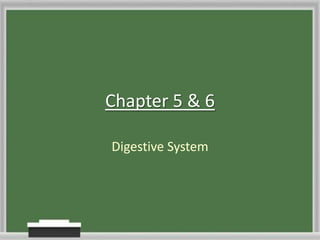
Digestive system presentation BUS 116
- 1. Chapter 5 & 6 Digestive System
- 2. Functions of the Digestive System Breakdown foods into a form usable by the rest of the body – chemical form Absorb broken down nutrients and get them into the circulatory system for transportation to cells Eliminate any waste products that cannot be absorbed into the blood stream
- 3. Digestive System Conveyor Belt Exterior to your body Peristalsis Nutrients taken; wastes excreted
- 4. Oral Cavity Food fibers are broken down by teeth, tongue and hard palate in mastication (chewing) Deglutition (swallowing) Rugae – located on hard palate to help grind up the food in preparation for digestion 32 Teeth Incisors: front teeth Molars: back teeth Mesial surface – toward midline of body Buccal surface – toward cheek Labial surface – touch the lip Distal surface – toward back or throat Incisal surface – part that comes together when you bite down (incisors) Occlusal surface – part that comes together when you bite down (molars)
- 5. Oral Cavity Continued Saliva – secreted into food to start the process of breaking down starches. Secreted by the: Parotid gland – just in front of ear Sublingual gland – under the tongue Submandibular gland – area of the lower jaw
- 6. Esophagus Epiglottis – stops food from entering the larynx Transport system to stomach
- 8. Small Intestines Duodenum Jejunum Ileum
- 9. Duodenum Finishes process of digestion Starts absorption process Pancreas and gallbladder secrete digestive juices Nutrients further metabolized
- 10. Jejunum & Ileum Absorption of nutrients All three sections (duodenum, jejunum & ileum) have villi which increase the absorption surface of intestines and quickly absorb nutrients
- 11. Large Intestines Water absorption Constipation vs. diarrhea
- 12. TERMS TO KNOW ETIOLOGY The process of studying the cause IDIOPATHIC Pertaining to unknown disease
- 13. TERMS TO KNOW ANOREXIA Lack of appetite in an ill patient ASCITES Accumulation of fluid in abdomen Characteristic of CHF
- 14. TERMS TO KNOW BORBORYGMUS Growling stomach Movement of gas, fluid or both in GI tract DYSPHAGIA Trouble swallowing Often occurs after person has a stroke
- 15. TERMS TO KNOW CONSTIPATION Fecal material stays in intestines too long becoming hard and compressed from excessive removal of water from stool DIARRHEA Stool passes too quickly through intestines resulting in no water loss from stool
- 16. TERMS TO KNOW FLATUS Gas expelled through anus ERUCTATION Gas expelled through mouth
- 17. TERMS TO KNOW HEMATOCHEZIA Bright red blood on outside of stool Sign of bleeding on the lower end of digestive tract Sign of hemorrhoids MELENA Black tarry stools Blood digested in stool – GI hemorrhage has taken place in the beginning to middle of the digestive system; most likely stomach or duodenum
- 18. TERMS TO KNOW NAUSEA Upset stomach feeling JAUNDICE Yellow-orange color of skin when high bilirubin is present in blood Icterus – color of the whites of the eyes
- 19. TERMS TO KNOW STEATORRHEA Fat in stool May be indication of pancreatic disease HEMORRHOIDS Varicose veins in the rectum Caused by increased pressure on rectum from constipation or pregnancy
- 20. TERMS TO KNOW APHTHOUS STOMATITIS Cancer sores Inflammation of the mouth with small ulcers HERPETIC STOMATITIS Blisters/cold sores Infection of herpes virus
- 21. TERMS TO KNOW – Please review in book! Dental caries Colonic polyposis Colorectal cancer Dysentery Gastric Carcinoma Ileus Irritable bowel syndrome Ulcerative colitis Cirrhosis Pancreatitis
- 22. TERMS TO KNOW ORAL LEUKOPLAKIA White plaques/patch on mouth Precancerous lesion Chewing tobacco PERIODONTAL DISEASE AKA pyorrhea Bacteria cause inflammation and degeneration of gums, teeth and surrounding tissue
- 23. TERMS TO KNOW ACHALASIA Lower esophagus/cardiac sphincter does not relax enough to allow food into stomach CROHN’S DISEASE Autoimmune disease Severe inflammation and destruction of tissue in colon Diarrhea, cramping, fever Chronic condition for which there is no cure
- 24. TERMS TO KNOW ANAL FISTULA Abnormal passageway from rectum to outside of body ANAL FISSURE Crack or slit in the mucous membrane of the anus
- 25. TERMS TO KNOW DIVERTICULA Out pocketing of intestine Irritation and inflammation which can result in diverticulitis ESOPHAGEAL VARICES Associated with cirrhosis of liver Liver becomes fibrotic and blood cannot pass through; blood backs up in hepatic portal vascular system into the vessels around esophagus; vessels become clotted and twisted
- 26. TERMS TO KNOW GASTROESOPHAGEAL REFLUX DISEASE GERD or heartburn Contents of stomach return up into the esophagus ULCER Open sore anywhere along digestive tract Most common is gastric and duodenal Caused by Helicobacter pylori
- 27. Hernia Hiatal hernia – stomach through diaphragm Ventral hernia – intestine through muscle and peritoneum in front abdomen Incisional hernia – intestine through location of a previous incision Inguinal hernia – intestine through inguinal ring Hernias can be: Reducible: can be pushed back into position within the abdomen Incarcerated: cannot be reduced and is held in position by the abdominal muscles Strangulated: incarcerated with a piece of stool lodged in that section causing swelling and blood supply being cut off
- 28. TERMS TO KNOW INTUSSUSCEPTION Telescoping of intestines; one piece inside the other Serious , painful and occurs often in children and young adults VULVULUS Twisting of intestines upon themselves More serious than intussusceptions and occurs in newborns and small children Requires immediate surgery
- 29. TERMS TO KNOW CHOLELITHIASIS Gallstones in gallbladder CHOLEDOCHOLITHIASIS Gallstones in gallbladder and duodenum
- 30. VIRAL HEPATITIS Hepatitis A: transmitted via oral/fecal route Hepatitis B: transmitted through blood route Hepatitis C: transmitted through blood route – worst of all because there is no cure
- 31. TERMS TO KNOW Laboratory tests in text Clinical procedures in text Abbreviations
- 32. ROOT OPERATIONS